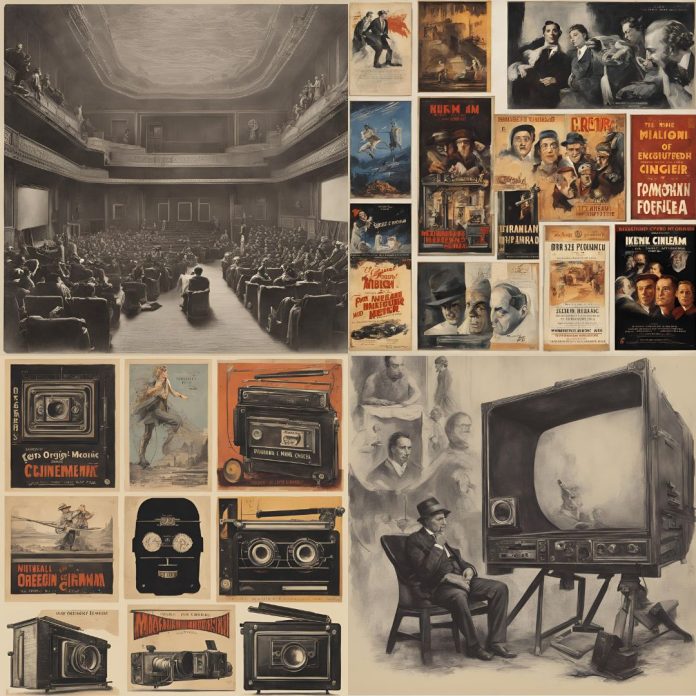Plays have always existed since the early times as a form of entertainment in every culture. The idea to record these performances and telecast them into a movie is a brilliant idea which brought this form of entertainment to the common man and right into their homes. The Cinema came into existence in the early 19th century as a series of technological developments: the creation of photography, the invention of the illusion of motion by merging single images, and the research of human and animal locomotion. History begins with these technological developments, where the idea of the motion picture as an entertainment industry first emerged. The world of cinema had many transformations, some driven by the artistic visions of individual participants, and some by commercial necessity.
The Beginnings
Thomas Edison, along with William Dickson discovered the kinetoscope in 1891, a device that became the pioneer of the motion picture projector. The kinetoscope was a cabinet with a window through which individual viewers could experience the illusion of a moving image. A celluloid film strip with a sequence of images creates the illusion of moving objects. The Lumières Brothers held the world’s first-ever commercial film screening in December 1895 in Paris, France using their device and cinematograph, a camera, a projector and a film printer all in one. A sequence of about 10 short scenes, including their first film, Workers Leaving the Lumière Factory, a segment lasting less than a minute and depicting workers leaving the family’s photographic instrument factory at the end of the day.
By 1906, the principles of colour separation were used to produce so-called ‘natural colour’ from black and white moving images with the British Kinemacolor process, first presented to the public in 1909. And with more Technical innovations filmmakers like Parisian cinema owner Georges Méliès experimented with special effects that produced magical transformations on screen like flowers turned into women, people disappearing with puffs of smoke, a man appearing where a woman had just been standing, and many other similar tricks. Edwin S. Porter’s 12-minute film, The Great Train Robbery (1903), broke with the stagelike compositions of Méliès-style films through its use of editing, camera pans, rear projections, and diagonally composed shots that produced a continuity of action, established the realistic narrative as a standard in cinema.
The Rise of the Feature Films
In these early years, theatres were still running single-reel films, which came at a standard length of 1,000 feet, allowing for about 16 minutes of playing time. Features generally experienced longer runs in theatres than their single-reel Motion Pictures. Additionally, the feature film gained popularity among the middle classes, who saw its length as analogous to the more “respectable” entertainment of live theatre. Following the example of the French film d’art, U.S. feature producers often took their material from sources that would appeal to a wealthier and better-educated audience, such as histories, literature, and stage productions. The first feature-length movie incorporating synchronised dialogue, The Jazz Singer (USA, 1927), used the Warner Brothers’ Vitaphone system, which employed a separate record disc with each reel of film for the sound.
The Art of Silent Film
The silent film era began in 1906 with Charles Tait directing The Story of the Kelly Gang in Australia, as the first-ever feature-length movie, The Story of the Kelly Gang was received well and succeeded financially. But it wasn’t until 1915 that so-called “movies” began to catch on as a mainstream art form. That’s when D.W. Griffith made The Birth of a Nation, and there the American film industry was truly born. The following 15 years saw the rise of Hollywood’s most memorable stars, with Charlie Chaplin who directed such successful movies like City Lights and Modern Times, Buster Keaton, and Greta Garbo all launching their careers during the silent film era.
Cinema competed with Television
While cinemas had some success in fighting the competition of television, they never regained the position and influence they held in the 1930s and 40s, and over the next 30 years, audiences dwindled. By 1984 cinema attendance in Britain had declined to one million a week. Over that time, the first British multiplex was built in Milton Keynes in 1985, sparking a boom in out-of-town multiplex cinemas.
Television changed a lot and its impact shook up how we consume media and storytelling. The advent of television in the late 1940s and early 1950s had a profound impact on the film industry. As more and more households began to acquire television sets, film studios saw a decline in movie theatre attendance. Studios were forced to adapt to this new medium, with many producing content for television, as well as exploring new ways to entice audiences back to the theatres.
The Birth of Hollywood
The first movie studio in Hollywood, the Nestor Company, was established in 1911. By the 1920s, Hollywood had become the centre of the American film industry. With the rise of television and the emergence of independent filmmakers, although referred to as the “Silver Age” of Hollywood, was marked by a shift towards more serious, socially conscious films, like On the Waterfront, A Streetcar Named Desire, and Rebel Without a Cause.
Golden Age of Hollywood Cinema
Earlier in the 1930s, nearly all feature-length movies were presented with synchronised sound and, by the mid-1930s, some were in full colour too. The advent of sound secured the dominant role of the American industry and gave rise to the so-called ‘Golden Age of Hollywood’. During the 1930s and 1940s, cinema was the principal form of popular entertainment, with people often attending cinemas twice a week. Ornate ’super’ cinemas or ‘picture palaces’, offering extra facilities such as cafés and ballrooms, came to towns and cities; many of them could hold over 3,000 people in a single auditorium. With over 19 thousand theatres in the US in 1949, the Golden Age of Hollywood was over
Indian Cinema
Indian Cinema’s growth came with Dadasaheb Phalke, known as the Father of Indian Cinema. In 1913, he released ‘Raja Harishchandra,’ India’s first full-length feature film, crossing the borders by becoming the first Indian film to be screened in London in 1914. The biggest turning point in the history of Indian Cinema arrived in 1931 with the release of ‘Alam Ara,’ directed by Ardeshir Irani and it was India’s transition to sound cinema, making it the first sound film in the country. ‘De de khuda ke naam par’ sung by W.M. Khan added a new dimension to the cinematic experience.
Directors like Satyajit Ray and Bimal Roy aimed at societal issues focused on themes like prostitution, dowry, and polygamy. In the 1960s, directors like Ritwik Ghatak and Mrinal Sen continued to address real-world problems, gaining international recognition. The 1970s introduced the era of Masala movies in Bollywood.
The Golden Age of Bollywood
The 1950s and 1960s were regarded as the golden age of Indian cinema. This era brought the rise of legendary actors such as Guru Dutt, Raj Kapoor, Dilip Kumar, Meena Kumari and more, their performances in Indian film history create timeless classics as per the history of Indian Cinema.
Today’s Cinematic Scenario
The last 20 years had a massive change spread across the Hindi film industry. We’ve survived the dawn of the digital era, transformed into an OTT-friendly space and finally embraced meaningful cinema all in a chase to make Bollywood more inclusive, more global, more impactful, and more wholesome. Many movies created history landing large numbers at the box office.
Examples: Jawan (684.71cr.), Pathaan (1,050.30 cr), Animal (554cr.)
Regional Films
Regional cinema had an impactful transformation over the years. These films have garnered international acclaim and critical appreciation. This cinema includes Tamil, Malayalam, Bengali, Marathi:
1- Tamil Cinema: Where Art Meets Entertainment
Tamil cinema, was established in Chennai (formerly Madras) as a significant film production hub in India. Over the 20th century, Tamil films gained global recognition with distribution to an increasing number of overseas theatres. Tamil cinema, often called Kollywood, is popular for its unique blend of art and entertainment. It has gifted Indian cinema with prolific actors, directors, and musicians. The Tamil film industry has contributed immensely to the growth of regional cinema, with its films garnering appreciation both nationally and internationally.
2- Magnificent Malayalam Cinema: Portraying Life’s Realities
Malayalam cinema, hailing from the state of Kerala, is renowned for its poignant storytelling and realistic portrayal of human emotions. The industry has produced exceptional talents and thought-provoking narratives, from the iconic works of legends like Adoor Gopalakrishnan and G. Aravindan to the new wave of filmmakers exploring bold themes, Malayalam cinema continues to captivate audiences.
3- The Eastern Enigma: Bengali Cinema
Bengali cinema started in Kolkata, is a treasure trove of artistic brilliance and intellectual storytelling. With its roots in literary heritage, the industry boasts of legends like Satyajit Ray, Ritwik Ghatak, and Mrinal Sen, who have crafted masterpieces that transcend time. Bengali cinema’s ability to beautifully capture human emotions and societal complexities has earned it recognition across the globe.
4- Majestic Marathi Cinema: Narrating Life’s Chronicles
Marathi cinema, originating from Maharashtra, shines bright with its focus on thought-provoking narratives and artistic finesse. Filmmakers like Dadasaheb Phalke paved the way for Marathi cinema, and contemporary directors continue to carry the torch with pride. Dadasaheb Phalke’s “Raja Harishchandra” (1913) was the first Marathi movie and a silent film With engaging storytelling and brilliant performances, Marathi cinema has made a significant impact on the Indian film industry.
The Modern Era–Blockbusters, Franchises, and Streaming Platforms
The modern era is characterized by the dominance of blockbuster films and franchises, as studios increasingly rely on tried-and-true formulas and familiar characters to draw in audiences. Superhero films, such as those in the Marvel Cinematic Universe, and long-running franchises like Star Wars and Harry Potter have become the backbone of the industry, generating billions of dollars in revenue.
In recent years, the rise of streaming platforms like Netflix, Amazon Prime, and Hulu has once again disrupted the traditional film industry. These platforms have not only provided new outlets for filmmakers to distribute their work but have also become major players in film production.
The Timeline of Cinema
- 1878: Eadweard Muybridge created “The Horse in Motion,” a series of photographs that laid the foundation for motion pictures.
- 1891: Thomas Edison and William K.L. Dickson invented the Kinetoscope, a peep-show device that shows short films to individual viewers.
- 1895: Auguste and Louis Lumière develop the Cinématographe, a portable motion picture camera and projector, and screen their first short films to a public audience in Paris.
- 1902: Georges Méliès releases “A Trip to the Moon,” one of the first science fiction films and a milestone in cinematic special effects.
- 1903: Edwin S. Porter directs “The Great Train Robbery,” one of the first narrative films and an early example of film editing.
- 1927: The first feature-length synchronized sound film, “The Jazz Singer,” is released, marking the beginning of the “talkie” era.
- 1930s: The Golden Age of Hollywood sees the rise of major studios like Warner Bros., MGM, and Paramount, and the production of classic films like “Gone with the Wind” (1939) and “The Wizard of Oz” (1939).
- 1940s: World War II influences filmmaking, with the production of propaganda films and the emergence of film noir.
- 1950s: The widescreen format and 3D movies gain popularity, and Hollywood faces competition from television.
- 1960s: The French New Wave and other movements challenge traditional filmmaking conventions, leading to more experimental and artistic cinema.
- 1970s: The era of the blockbuster begins with films like “Jaws” (1975) and “Star Wars” (1977).
- 1980s: The rise of home video changes the way people consume movies, and special effects technology advances with films like “E.T. the Extra-Terrestrial” (1982) and “Jurassic Park” (1993).
- 1990s: The indie film movement gains momentum, and computer-generated imagery (CGI) becomes more prevalent in filmmaking.
- 2000s: The shift to digital filmmaking accelerates, and franchises like “Harry Potter” and “The Lord of the Rings” dominate the box office.
- The 2010s: Streaming platforms like Netflix and the Marvel Cinematic Universe reshape the industry, while diversity and inclusion in the film become prominent topics.
- 2020s: The COVID-19 pandemic disrupts the film industry, leading to delays in releases and increased emphasis on streaming services.
Cinema, whether regional, Bollywood, or Hollywood plays an integral role in our daily lives. Beyond entertainment, it addresses societal issues and influences our perspectives. With its rich history and promising future, Indian cinema remains a powerful force that impacts the minds of audiences worldwide.





























